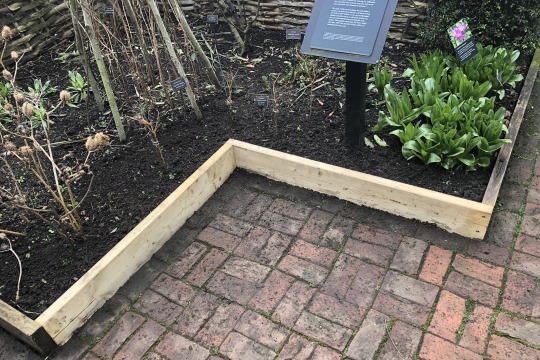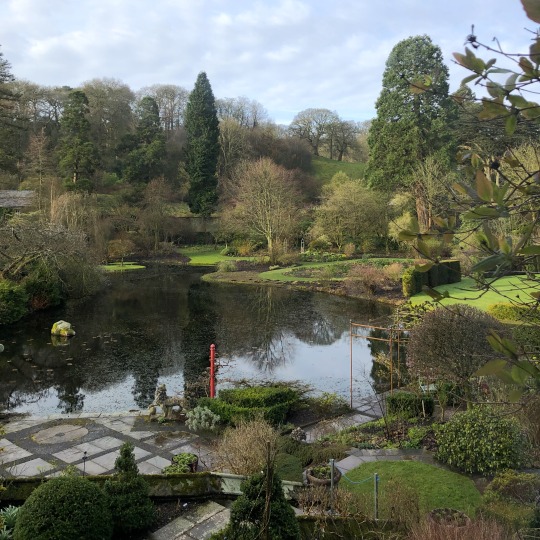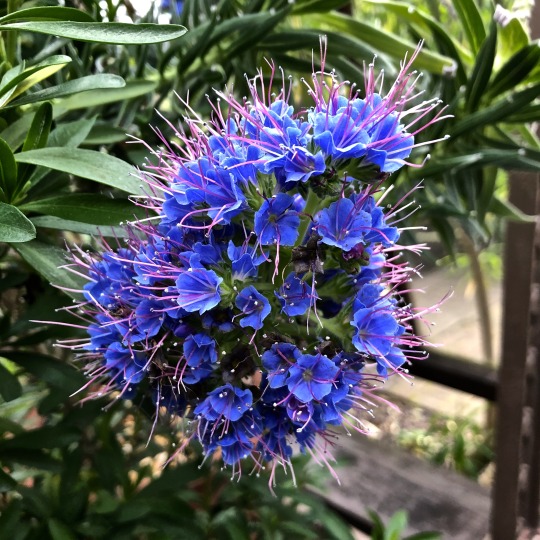#i later sent this photo to christy road to use as a reference
Explore tagged Tumblr posts
Text

Me, at Fuel Cafe // Milwaukee, WI // July 2001
(photo taken by Ali F.)
#photography#analog photography#not my photo#photos of me#fuel cafe#milwaukee#2001#i later sent this photo to christy road to use as a reference#when she drew a cover for my zine in 2002#also#god damn i miss fuel#ali aka filia#ashtrayfloors
5 notes
·
View notes
Text
24 February - 14 March
Tomorrow is the Ides of March...what else can happen?
It’s been a busy few weeks in the garden and I’ve been to Antwerp and up to Gresgarth Hall, so a lot to report.
I re-mounted a Platycerium for the first time. It was interesting to see how they pile up on each other and how easy it was to pull off the dead ones and keep the one thriving one. Only two years ago this had only one pathetic little frond. I have nursed it back to a nice specimen and now have given it a new mounting. See photo under plant of the week below...
I enjoyed the last weekend of February in Antwerp with Jody and Steve who live there. It was the end of winter hours at work, so I was able to get away on the 15.00 train. We had a nice weekend.
The first of March brought us back to summer working hours (08.00 to 17.00 Monday through Thursday and 08.00 to 16.00 Friday). I replaced some raised bed wood that had rotted away in the pharmaceutical area.

We had two days of students installing art all around the garden for their course. It was fun to see it installed. It was only up for two days, unfortunately.

Last weekend I went up to Gresgarth Hall as a guest of Arabella and Mark Lennox-Boyd. I work on the database for the arboretum at Gresgarth. I met the new members of the gardening staff and upgraded their databases. Gresgarth is a beautiful place to escape London (and CoVid-19).


Monday morning at 06.13 I took a photo, through the bus window, crossing Putney Bridge on my way to work.

Later that day, one of our volunteers, Charlotte Lorimer, sent me this... Amazing!

This past week I spent three days working on turf, so by Thursday, with sore chest muscles, of course I initially equated that with ‘breathing difficulties’. I stopped, and realised I just had sore muscles. Ah, how CoVid-19 is playing with my mind. I then had an opportunity to add my own art to the garden. I was asked to try to protect new grass seed from birds, this is what I came up with...

We are growing bananas from seed for the first time and this is a photo of them germinating on 3 March and again, one week later on 10 March.

A volunteer donated a tablet to the garden so we will be able to use our database in the garden, once I figure out how to set it up! This is very exciting and should save us a lot of time. We expressed out huge gratitude to the wonderful volunteer who made this possible.
There is a lot of yellow in the garden at the moment, one of the showiest is Forsythia x intermedia ‘Beatrix Farrand’ which are located by the Embankment gate.

Plant ident on winter twigs by Joe:
Betulaceae Betula pendula
Betulaceae Carpinus betulus
Betulaceae Corylus avellana
Cornaceae Cornus sanguinea
Fagaceae Castanea sativa
Fagaceae Fagus sylvatica
Grossulariaceae Ribes nigrum
Rosaceae Prunus avium
Sapindaceae Acer griseum
Sapindaceae Aesculus hippocastanum
Plant of the week 28 February
Polypodiaceae Platycerium bifurcatum (Cav.) C. Chr.

common name(s) - common staghorn fern, common stag's horn fern, Australian elk's horn fern, elkhorn fern, antelope ears synonym(s) - Acrostichum bifurcatum Cav.; Alcicornium bifurcatum (Cav.) Underw. conservation rating - none native to - Eastern Australia & New Caledonia location - tropical corridor, accession 2008-0538, and fernery, accession 2008-0537 leaves - heart-shaped sterile fronds and grey-green, arching, fertile fronds to 900mm long, forked into strap-shaped segments, bearing brown spore patches beneath the tips flowers - none habit - evergreen, epiphytic fern habitat - a bracket epiphyte occurring in and near rainforests pests - scale insects disease - generally disease-free hardiness - to 1ºC (H2) soil - epiphyte sun - part shade, sheltered propagation - sow spores when ripe or detach plantlets pruning - none nomenclature - Polypodiaceae - polypodium - many-feet, Dioscorides’ reference to the rhizome growth pattern, polypody; Platycerium - broad-horned, the stag’s-horn-like, dichotomous lobing of the fertile fronds; bifurcatum - divided into equal limbs NB - AGM
References, bibliography:
Gledhill, David, (2008) “The Names of Plants”, fourth edition; Cambridge University Press; ISBN: 978-0-52168-553-5
IUCN [online] http://www.iucnredlist.org/search [14 Mar 20]
Missouri Botanical Garden [online] http://www.missouribotanicalgarden.org/PlantFinder/PlantFinderDetails.aspx?kempercode=b615 [14 Mar 20]
Plant List, The [online] http://www.theplantlist.org/tpl1.1/record/tro-50050265 [14 Mar 20]
Plants of the World [online] http://plantsoftheworldonline.org/taxon/urn:lsid:ipni.org:names:17177460-1 [14 Mar 20]
Royal Horticultural Society [online] https://www.rhs.org.uk/plants/details%3Fplantid%3D1488 [14 Mar 20]
Wikipedia [online] https://en.wikipedia.org/wiki/Platycerium_bifurcatum [14 Mar 20]
Plant ident of Jess’s favourites in the dicotyledon beds:
Apiaceae Ferula communis subsp. communis
Asteraceae Scolymus hispanicus
Asteraceae Serratula shawii
Caryophyllaceae Gypsophila acutifolia
Cistaceae Citrus trifoliata
Fabaceae Coronilla valentina subsp. glauca 'Citrina'
Fabaceae Glycyrrhiza yunnanensis
Ranunculaceae Clematis serratifolia
Rhamnaceae Paliurus spina-christi
Solanaceae Eriolarynx australis x Eriolarynx fasciculata
Plant of the week 6 March
Boraginaceae Echium candicans L.f.

common name(s) - pride of Madeira synonym(s) - Argyrexias candicans Raf.; Echium brachyanthum Hornem.; E. candicans var. noronhae Menezes; E. cynoglossoides Desf.; E. densiflorum DC.; E. macrophyllum Lehm.; E. maderense Steud.; E. marianum Boiss.; E. pallidum Salisb.; E. pavonianum Boiss.; E. truncatum auct. conservation rating - Data Deficient native to - Madeira, Portugal location - glasshouse two Macaronesian plants, accession 1991-0343 leaves - grey-hairy lance-shaped evergreen leaves flowers - dense terminal spike-like panicles of white, pale or deep blue flowers in spring and summer habit - bushy biennial sub-shrub habitat - forest, rocky areas (e.g. inland cliffs, mountain peaks), shrubland pests - outdoors slugs; indoors glasshouse whitefly, glasshouse red spider mite, vine weevils disease - generally disease-free hardiness - to 5ºC (H1c) soil - under glass, grow in a loam-based potting compost, in full light; water freely when in growth, sparingly in winter. Outdoors, grow in moderately fertile, well-drained soil in full sun. Protect from winter frost in situ with horticultural fleece sun - full sun, sheltered propagation - seed at 13 to 16°C in summer, overwintering seedlings at 5 to 7°C pruning - none nomenclature - Boraginaceae - borago - shaggy-coat, burra with feminine suffix (the leaves); Echium - viper, a name used by Dioscorides for a plant to cure snakebite, viper’s bugloss Echium vulgare; candicans - white, hoary-white, with white woolly hair, present participle of candico NB - in California, it is an invasive species. It is removed from native plant communities as part of habitat restoration efforts in coastal parks such as the Golden Gate National Recreation Area. In New Zealand it is a common garden escapee onto road-side verges and shingle banks throughout the drier parts of both the North and the South Islands. In the state of Victoria, Australia, it is considered to be a high weed risk and an alert has been posted by the Department of Primary Industries.
References, bibliography:
Gledhill, David, (2008) “The Names of Plants”, fourth edition; Cambridge University Press; ISBN: 978-0-52168-553-5
IUCN [online] https://www.iucnredlist.org/species/162036/115869493 [14 Mar 20]
Plant List, The [online] http://www.theplantlist.org/tpl1.1/record/kew-2784037 [14 Mar 20]
Plants of the World [online] http://plantsoftheworldonline.org/taxon/urn:lsid:ipni.org:names:115594-1 [14 Mar 20]
Royal Horticultural Society [online] https://www.rhs.org.uk/Plants/6290/i-Echium-candicans-i/Details [14 Mar 20]
Wikipedia [online] https://en.wikipedia.org/wiki/Echium_candicans [14 Mar 20]
Plant ident on plants from Macaronesia by Louisa:
Arecaceae Phoenix canariensis
Asparagaceae Dracaena draco
Asteraceae Argyranthemum frutescens
Asteraceae Schizogyne sericea
Athyriaceae Diplazium caudatum
Boraginaceae Echium wildpretii
Crassulaceae Aeonium spathulatum
Lauraceae Laurus azorica
Pinaceae Pinus canariensis
Plantaginaceae Plantago famarae
Plant of the week 13 March
Rosaceae Prunus spinosa L.

common name(s) - blackthorn, sloe, sloe plum, buckthorn, bullace, skeg, snag synonym(s) - Druparia spinosa Clairv.; Prunus acacia Crantz ex Poir.; Prunus acacia Crantz; Prunus acacia-germanica Crantz; Prunus domestica var. spinosa (L.) Kuntze conservation rating - Least Concern native to - Europe, Morocco, Algeria, Tunisia, Turkey, Syria & Iran location - useful garden - survival bed, accession 2017-0263 leaves - dark green, ovate leaves flowers - small white flowers in early spring, followed by ovoid, bloomy black fruits 15mm across habit - small thorny deciduous tree to 3m tall and 3m wide habitat - shrubland, artificial/terrestrial, rocky areas (e.g. inland cliffs, mountain peaks), forest pests - aphids, caterpillars, bullfinches disease - silver leaf, blossom wilt hardiness - to <-20ºC (H7) soil - any moist well-drained soil sun - full sun propagation - sowing the stones shallowly (no more than their own length deep) in a well-drained growing medium. In order to germinate, the stones must be exposed to a period of cold for approximately two months. This can be achieved by placing them in a bag of moist sand in a fridge. Semi-ripe cuttings can be taken in late summer. Blackthorn tolerates most soils, except acidic ones, but does not perform well if shaded. Once it is established it is a tough, resilient plant pruning - in mid-summer if silver leaf is a problem nomenclature - Rosaceae - rosa - the Latin name for various roses; Prunus - the ancient Latin name for a plum tree; spinosa - spiny, with spines NB - flavouring for alcoholic beverages (sloe gin), when tea derived from Camellia sinensis (a commonplace drink today) was a very expensive product, the young leaves of blackthorn were dried and used as a replacement for, or to adulterate, the more expensive tea. Blackthorn wood has been used to make walking sticks, clubs and hay-rake teeth. A shillelagh is a highly polished stick of blackthorn wood that was made and used in Ireland, and a blackthorn walking stick is still carried by commissioned officers of the Royal Irish Regiment. Blackthorn wood is especially hard and takes a high polish. The shillelagh was used in self defence and is now used in a form of traditional fighting or martial art. Stout sticks of blackthorn are highly prized since it is rare to find blackthorn grown to this size.
References, bibliography:
Gledhill, David, (2008) “The Names of Plants”, fourth edition; Cambridge University Press; ISBN: 978-0-52168-553-5
IUCN [online] https://www.iucnredlist.org/species/172194/19400568 [14 Mar 20]
Plant List, The [online] http://www.theplantlist.org/tpl1.1/record/rjp-43 [14 Mar 20]
Plants of the World [online] http://plantsoftheworldonline.org/taxon/urn:lsid:ipni.org:names:730297-1 [14 Mar 20]
Royal Horticultural Society [online] https://www.rhs.org.uk/Plants/14041/Prunus-spinosa/Details [14 Mar 20]
CoVid-19 is consuming me now. I altered the way I return home from work after Wednesday’s nighmarish journey on the underground. Trains were only every twenty minutes to Richmond so we were packed in like sardines. Now I’m walking across the river to Queenstown Road and catching a train. There is much more room on the train. I’m addicted to following the numbers on this incredible Johns Hopkins University website:

Stay healthy if you can, and self-isolate if necessary. This will pass in time...
0 notes